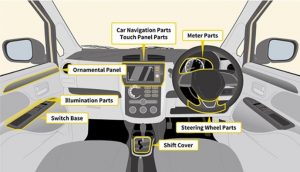Film Insert Molding (FIM) – Economic alternative for Plastic Decoration
Polymers have contributed immensely to the growth of automotive industry. Starting with common plugs and connectors, today, polymer films are playing crucial role in making Human-Machine Interfaces sleeker and feature rich. The way we have been using plastics in automotive industry has been evolving. Film Insert Molding, a comparatively newer approach towards working with polymer films is already revolutionizing automotive HMIs. In this article, we will get a quick introduction to usage of Film Insert Molding for In-Mold Decoration.
Rise of Plastics in Automotive
In 1839, Charles Goodyear patented vulcanized rubber, the first polymer made by modifying the mechanical properties of natural rubber which found its application in tires. This is when the automotive industry and plastics started sharing a common history. Bakelite invented by Leo H. Baekeland in 1907, proved to be a perfect material for making plugs, handles and switches due to its excellent insulating properties. Until 1960s, new discoveries in the field of polymers made it possible to develop thermosetting polymers such as polypropylene and in 1970s, polymers were first used to decorate vehicle interiors (Coverings, skins, woodwork etc.). Because of its anti-ageing properties and ability to withstand impacts thermosetting polymers and subsequently thermoplastic resins were widely used for external applications by eighties and nineties (Bumpers, fenders, headlight, tailgates). The decade of 2000 – 2010 was when automakers took efforts in reducing their vehicle’s weights and replacing traditional materials such as steel and aluminum. The increasing use of plastics, that offered designers a great creative freedom, between 2010-2020, also helped automakers in complying with environmental requirements and regulations aimed at reducing emissions. Car manufacturers are creating lighter vehicles, by replacing metal with composite materials to meet the CO2 emission thresholds.
HMI in Automotive interiors
For past few years, new Human-Machine Interfaces (HMI) have redefined car interiors with automakers and Tier 1 manufacturers implementing smart interfaces and advanced technologies. This change from mechanical to electronic interfaces and controls has revolutionized the overall driving experience. Voice controls, touch-sensitive surfaces and wireless communication are just some of the features that are replacing mechanical interfaces.
New technologies and features based on enhancing the HMI in automotive interiors are playing a crucial role in maximizing physical comfort and provide sleek and cutting-edge aesthetics. Ultimately aiming to give drivers and passengers an experience as immersive as their smartphones, some of the features being currently worked upon are as follows,
- Contemporary aesthetics
- Touch interfaces
- Superior lighting
- Physical comfort
- Wireless communication
- Internet/cloud connectivity
Recent advancements globally
In an Article, the chairman of the Decorating and Assembly Division of the Society of Plastics Engineers and a technical person at APTIV, Paul Uglum, mentioned this thought concerning various design trends that may emerge.
He indicated that globally the Original Equipment Manufacturers (OEMs) are pursuing a variety of aesthetic trends to establish unique market positions.
Paul added, there is a desire to move away from the flat panels or glasses that are used for various displays in automotive interiors. A strong movement towards curved or more complex surfaces is apparent. There is also a significant movement towards In-Mold Labelling (IML) and In-Mold Decoration (IMD) to create complex surfaces for the displays and panels.
Real wood grain and fake wood grain continue to be in demand, due to its durability, appearance, wear resistance and long-term cleanability. The UV-cured high-gloss black finish (Piano Black) with aggressive wear resistance standards with an increasing use in vehicle interiors, also remains popular.
IMD / FIM and its potential
Plastics processing companies are considering formable films as economical, durable as well as environmentally friendly means of producing decorated parts. IMD with formable film inserts has a potential to replace traditional post-mold painting, printing, hot stamping, and chrome plating. The process achieved its first success with small sized and relatively flat parts for cell phones and automotive interior and exterior.
As we all know, paint is one of the most expensive components on a car, paint line is the biggest investment in an automotive assembly plant occupying half the plant floor space. A type of in-mold decoration, FIM eliminates the need for separate steps, such as coating or painting, even in-cases of complex 3D shaped objects. It also lowers scrap rates and improves recyclability. Also offering manufacturers, extensive flexibility in design and manufacturing with a considerable savings in costs, time, and machine investment. It can mold and decorate in one location and is able to achieve a Class A surface without the flow marks that may occur with molded-in color. The decorated film used in FIM can create a wide variety of visual effects for example monochromatic, multi-colored, or metallic etc. The process also allows for integrated graphics/symbols, back-lit design, surface finish (glossy, textured, or matte) and high gloss finish set selectively.
The decoration of parts can be changed quickly without interrupting production, by simply inserting different printed films. Additional properties like UV-resistance, scratch resistance, soft-touch finish, or electrical conductivity, can be achieved using coated films or composites. Printing, forming, trimming, and back injection are the key elements of the FIM process, and each process has its own unique technological considerations.

Film-insert decorating process begins with a thin plastic sheet that is printed, coated, or pigmented for decorative effect, and formed to the desired shape of the final part. Further trimmed and placed in an injection cavity, where it is back molded with a compatible substrate. The surface can be a solid color, metallic appearance, woodgrain finish, or symbols and graphics. In cars, decorative formable films are suitable for instrument and door panels, switches, bezels, and Centre consoles. A continuous growth is anticipated as OEMs look to diversify their products with different finishes and looks.

Picture Courtesy: www.m-chemical.co.jp
More recently, IMD/FIM has expanded well beyond injection molding. Decorated formed film inserts can now be used over substrates of thermoplastic or polyurethane composites. Direct forming of finished parts known as Thick sheet forming (TSF), with decorative films is emerging as another promising approach to finishing bigger exterior parts such as truck bumpers, rocker panels, and tonneau covers. IMD advocates say auto body panels made with formable films have scratch and impact resistance equal to or better than painted sheet metal.
FIM is a highly specialized process and if done properly, can lead to a much-refined product quality at competitive prices. Please write to me at prashant@quanzen.com to know more.




